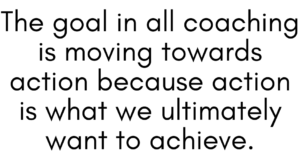In the Spring of 1998, I started a new job as a Program Manager at Oracle. This was my first official managerial job, but I wasn’t managing people; I was managing programs and projects, and it came with a big bump in responsibility. That was the part that got me really nervous. I probably felt some “imposter syndrome” about managing global teams and projects with big budgets. I also had a fear of public speaking. 
What did I do? I didn’t have a coach at that time. I wasn’t even aware of coaching as an option back then. So, what I did was to roll up my sleeves and start working on myself and work on the problem.
The problem was: I felt unprepared to succeed in this new role. So, I read books and listened to audio programs to get ideas on how I could become better organized to achieve success faster in this new role.
One of the ideas I applied was to go in on Saturdays and spend a half day alone in my office preparing for the week ahead: writing out plans, getting a head start on emails, looking at my projects, that sort of thing. The plan was to make me feel better and more confident about coming into work on Monday morning.
Then, during the week, I’d walk around with a set of 3 x 5 notecards in my pocket. I would write next steps on projects, with each card dedicated to a different project or initiative that I was working on. Using the cards, I’d be better able to keep track of my progress and my upcoming tasks. Sure, I could have done this in some sort of electronic fashion, but I found that the physical cards gave me more confidence that I was on track. ![]()

Something else I did was to start listening to classical music at work. I’d heard that classical music can help a person be more creative and possibly be calmer in stressful situations. So, I brought my boombox into my office and played classical CDs with the door closed.
These were some of the tactics I applied to become more successful, and believe it or not, they did help. I also spent more time networking with other people throughout the company to try and develop good working relationships. I felt better too because I was actively working on the problem.
If I was being coached and I wanted to be coached as “a person,” then the coach might have talked to me about my feelings and what was underlying my fears of being miscast for this important new role. And maybe we would have talked about whether the “imposter syndrome” was contributing to my feelings that I didn’t deserve this job. Exploring these kinds of thoughts and feelings is what happens when “coaching the person.” And you should understand that there’s nothing wrong about choosing to coach “the problem” instead. Coaching the problem can sometimes end up leading to growth in the person.
Remember that some clients will want you to start with coaching the problem, whereas other clients may want you to go deeper with them by exploring their feelings and the underlying issues that are leading to the problem. So, feel your way through the relationship with the client, sensing which way they may want to go.
Chances are before you develop a strong level of trust and intimacy with the client, you’ll start with coaching the problem. And as you go deeper with the client in the relationship, you’ll start to coach the person. It really depends on the comfort level the client has and what they want.
 The goal in all coaching is moving towards action because action is what we ultimately want to achieve. Even if you’re coaching the person, eventually that’s going to lead to some action that will cement and reinforce the new view that the person has of themselves and possibly the way they see the world as well. One way or another, you’re going to lead them to action.
The goal in all coaching is moving towards action because action is what we ultimately want to achieve. Even if you’re coaching the person, eventually that’s going to lead to some action that will cement and reinforce the new view that the person has of themselves and possibly the way they see the world as well. One way or another, you’re going to lead them to action.
If you have further interest in exploring this topic, I recommend the book “Coach the Person, Not the Problem,” written by Marcia Reynolds. It’s a fantastic resource to support your growth in this area of coaching. Here are 10 great books about executive and leadership coaching to help you further develop your coaching skills!
I hope this post was helpful to you on your coaching journey. If you’d like to go further with me, consider joining the Center for Executive Coaching. We have 3 levels of enrollment and payment plans to suit your pace and budget. Learn more here.
Here are more articles and videos related to this article:
Articles
- Thoughts on Coaching the Person and Not the Problem
- Coaching the Uncoachable
- A sure sign of the impact of coaching
- 5 Models for Leadership Coaching
YouTube Videos
- 3 Ways to Work With an Unfocused Client
- Should You Coach a Client Who is in Trouble at Work?
- How to Increase Confidence and Transparency in Your Executive Coachee
- What Makes For a Good Executive Coaching Client? (And not so good?)
- Evaluating vs. Encouraging Your Coaching Client – What’s the Difference?
Photo copyright: Featured photo is from ©Kampus Production via Pexels. Second photo is from ©Mart Production via Pexels.







